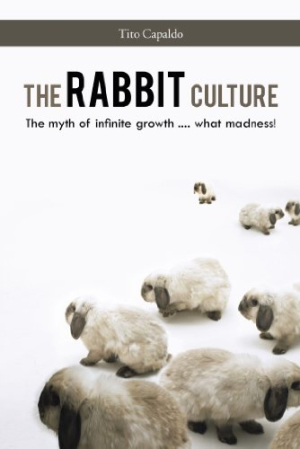The Rabbit Culture
The Myth of Infinite Growth...What Madness!
Capaldo conveys adoption and contemporary Italy with thoughtful details.
The Rabbit Culture explores the unique challenges of adoption but digs even deeper into the economic, political, and social environment of Italy in the new millennium. Tito Capaldo expresses tenderness and understanding for his adopted son while also railing against regulations and legislation within his country. The result is a dense and impassioned look at all levels of government and a glimpse at how one boy influenced the man who became his father.
Capaldo’s Italy—the rural Campo di Giove where he spent his childhood and the busy province of Latina where he lives with his family–is depicted with captivating details. A description of the annual pig slaughter in Campo di Giove, a celebration of and preparation for the coming months of winter, creates an atmosphere of simple and gracious living that he holds up in comparison to the politically complicated world he lives in as an adult.
His trips to Romania to visit the orphanage with his wife are atmospheric, and Capaldo efficiently conveys the eerie sense of being out of place with thoughtfully captured details of the sky at night on a remote road through Transylvania. Capaldo and his wife are introduced to Marco and he reacts: “I had just met my son and I could not talk to him, we kept gazing upon each other, making eye contact, with a feeling of benevolent challenge.” He captures his complicated emotions of pride and solidarity and recalls that “without realising it I had overcome what is defined as tie of blood.”
The story of Marco and Tito is often pushed aside to focus on political and religious discourse. The author is opinionated and informed, but rather than build that knowledge into his story, he occasionally segues awkwardly into lists of facts, figures, and nearly manic questions and answers. When writing about Marco and his family life, the story is fluid and connected. This is often interrupted by less cohesive political commentary. In the beginning of the chapter “Drugs,” Capaldo explains that Marco has behavior issues and is living in a therapeutic community that is also a place for drug addicts. This instigates a “brainstorming” which begins:
- drugs and their consumption are immoral and the Government is doing the right thing to prohibit them;
- drugs are agricultural products, just like potatoes, therefore eating potatoes is also immoral;
- potatoes are good and drugs are bad
Capaldo follows this with, “Ok now browse in internet and find some data,” then relates a host of disconnected statistics on opiates and drug trafficking. Capaldo’s English is also imperfect, with frequent phrases like “what a nonsense” and “if it written, it is much better” detracting from the power of the story.
There is a unique and valuable story at the core of The Rabbit Culture, but it is surrounded by a great deal of opinion and information from sources that are not cited. Still, if organized in a more consistent voice, with fewer errors in grammar and punctuation, this narrative could reveal an interesting political portrait of Italy. The cover and title of the book, while visually intriguing, seem to convey Capaldo’s philosophy of social responsibility as it relates to overpopulation rather than the narrative about his family life.
Ultimately, as Marco matures and his troubles grow uncontrollable, Capaldo emerges as a wise father and a much improved author. When focused on his relationship with Marco, particularly under the direst circumstances, Capaldo finds his voice as an author and breaks his heart to share Marco’s story.
Reviewed by
Sara Budzik
Disclosure: This article is not an endorsement, but a review. The publisher of this book provided free copies of the book and paid a small fee to have their book reviewed by a professional reviewer. Foreword Reviews and Clarion Reviews make no guarantee that the publisher will receive a positive review. Foreword Magazine, Inc. is disclosing this in accordance with the Federal Trade Commission’s 16 CFR, Part 255.

